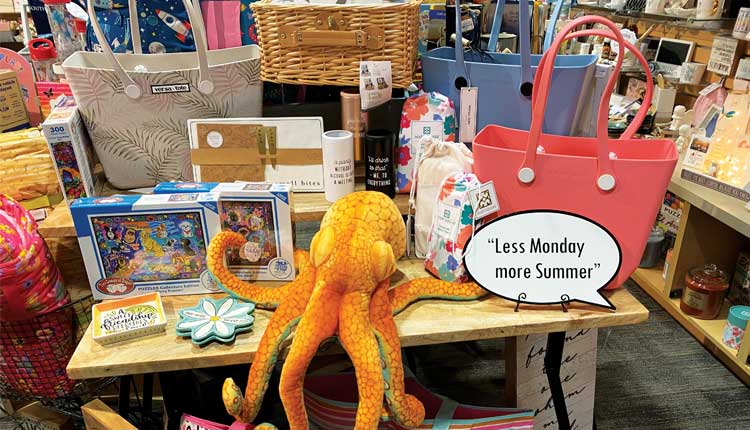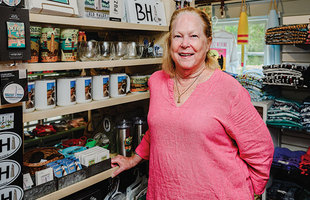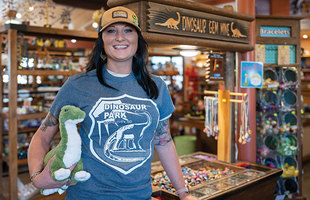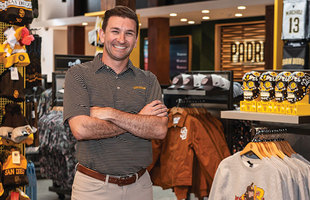It’s a happy place, a welcome break from stress and sometimes sadness — a spot where people from all walks of life can find a smile and a spirit-lifting conversation. The gift shops at University of Pittsburgh Medical Center (UPMC) in Harrisburg, Pennsylvania, are much more than places to buy candy and flowers.
“Sometimes, a person will come in and stay for 45 minutes talking to our employees or volunteers, and this shows us why we are here,” says Barbara Ipjian, gift store manager. “It’s not just to sell an item. We are here to help customers.”
Supervisor Nancy Leppo recalled telling a new employee during training, “You don’t know why someone comes in. It could be the worst day of their life or the best day of their life.”
Because of this, employees must stock for a range of experiences while also keeping in mind their constant customer base: hospital employees who enjoy the convenience of finding gifts and goodies. Sometimes, price is no object.
Case in point: a rustic, large-scale hand-painted sign from Second Nature by Hand retails for $129.99. It features a phrase found on a cellar wall during the Holocaust, and it reads, “I believe in the sun when it is not shining. I believe in love even when I cannot feel it. I believe in God even when He is silent.”
The shops stock products including luxuriously soft baby blankets and comfort shawls, Willow keepsakes, special picture frames, home decor, pet items, wedding gifts and clothing. Variety is key.
Because of this, the shops are a destination for customers who specifically visit to shop, not to see a doctor. Leppo says, “Employees come down to the shop to look for gifts, and we have people who come in off the street.”
Stocking a variety
Ipjian and Leppo buy for five UPMC shops. They price the items and sort them so their inventory is stocked at each location. Some goes into storage to refill shelves. The two have worked together in the shops for years and are longtime friends.
They mainly purchase all products at Atlanta Market, staying for five or six days, spending full days sourcing items on the floor. They have products shipped throughout the year.
“We have learned our clientele and what they will pay for something,” Ipjian says, noting that there’s not a certain customer demographic that will spend more or less. Sometimes, purchases are emotionally driven. Leppo adds, “Grandparents come in and spend $100 or $200 on various baby items because they just had their first grandchild and are so excited.”
Other times, guests are in a need-it-now mode for a gift and are more focused on finding an item that suits the occasion than the price tag. On the other hand, the two are occasionally surprised when a category like jewelry sits on the rack longer than a pet bereavement blanket.
Plus, it’s not uncommon for some guests to enter the shop simply because they want to look around rather than sit in a hospital room. “They need a break,” Leppo says. “So, it’s like therapy. They can come down and read the decorative signs, many of them are inspirational and some are snarky and funny.”
Both come from a retail background and focus on collecting items from a wide range of vendors — hundreds, actually. Stuffed animals might be priced at $9.99 or $99. Travel cups and canteens can carry a $34.99 tag and appeal to doctors and nurses on-site.
The shops also carry gift baskets from community groups that support local charities, schools and the hospital. In fact, all proceeds from the gift shops go back to UPMC for patient care services.
Beyond selling
Success for UPMC gift shops is more than selling items. “We are driven to succeed, but mostly we are there to help, and that is the biggest difference between a hospital-owned gift shop and a shop owned by an individual with a rented space,” Ipjian points out.
Training is crucial — and product knowledge does move inventory which, in turn, supports the hospital. “We educate our employees and volunteers if a product is sustainable, if a company gives back, if it’s made in the USA or if the item can be used in various ways,” Leppo says, referring to a scarf that can be tied in five different manners.
When they find a new product, employees receive literature so they can learn more about it. “I started writing a newsletter with all of our new product information on a monthly basis and leaving it for employees and volunteers to read while they are on their shift,” Leppo says.
“Sometimes, a person will come in and stay for 45 minutes talking to our employees or volunteers, and this shows us why we are here. It’s not just to sell an item. We are here to help customers.” — Barbara Ipjian, University of Pittsburgh Medical Center
Prior to the pandemic, the shop set out testers for beauty products and fragrances, even food. While this is no longer the case, employees receive samples so they can try and share their insight with guests. “They can talk about their firsthand experience using it and when selling it, they can convey that,” Leppo explains.
Hospital employees also share what they love with each other, sparking more sales. For example, when a nurse purchased a FarmHouse Fresh kit with items including Honey Heel Glaze, she shared how well it works. “We sell so much of it now and we offer the bigger size,” Ipjian says.
Certain brands like Willow Tree and Mud Pie sell themselves. Shops also carry Malabar baby blankets made famous by Meghan Markle and Prince Harry that wear a price tag of $54.99. Blankets sell from $39.99 to $79.99. Some are made by Goose Waddle and others by Demdaco include inspirational sayings.
As for apparel, the shops mostly carry one-size-fits-all items or flowy styles because there are no dressing rooms. “We buy items that are flattering to a lot of different body types,” Ipjian says, relating that the shops will accept exchanges within seven days of purchase if tags are still on and a receipt is provided. But this is rare.
Clothing lines include Top It Off, Mary Square, Coco + Carmen and Hello Mello pajamas and robes. Clothing can range from $9.99 for a UPMC logo shirt to $19.99 for tees to $100 and more for capes with fur accents.
Ipjian says, “Someone might come into the ER and need something to wear home.”
As for presentation, “Things in boxes do not sell well for us, we have learned,” Leppo says. The shops’ displays are arranged with this in mind and also organized into departments. “Each shop has a men’s section, a retirement section, pet section, wedding, clothing, jewelry, frames and gifts like stuffed animals and flowers.”
Windowfronts highlight feature items, which are switched up regularly. And decorative signage might be propped out in the lobby by the doors to shops. “People read them and purchase them, so it’s visual,” Leppo says.
Overall, the customer experience in UPMC gift shops is highly visual — and most of all, personal.
Indeed, Ipjian says, “We are that happy place for employees and visitors.”



